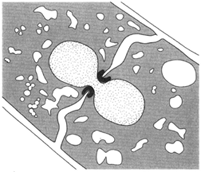The Ascomycetes
 |
| Figure 19-1 The end wall of a cell, showing a central perforation through which a nucleus is passing. Drawn from an electron micrograph. |
The Ascomycetes subclass of fungi is very large, encompassing perhaps as many as 37,000 species and including the blue and green molds of cheeses, Penicillium, truffles, and yeasts. The most distinguishing characteristic of Ascomycetes is the formation of an elongated, spore-bearing structure called the .ascus. An ascus typically contains eight ascospores. Ascus formation is associated with the perfect phase in reproduction. Ascomycetes fungi are septate, having cross walls in the hyphae; and the cross walls are incomplete, having perforations that allow a continuous cytoplasm from cell to cell. These perforations also allow the passage of nuclei from cell to neighboring cell, a process that has been observed to take place with great rapidity. The presence of cross walls helps distinguish Ascomycetes from Phycomycetes, where cross walls are absent. Another striking feature of Ascomycetes is the growth of a long, tubular, receptive emergence on the oogonium (ascogonium). This tubular emergence is called the trichogyne. The fact that a trichogyne is also observed in red algae (but not elsewhere) suggests a possible kinship between these two groups.




